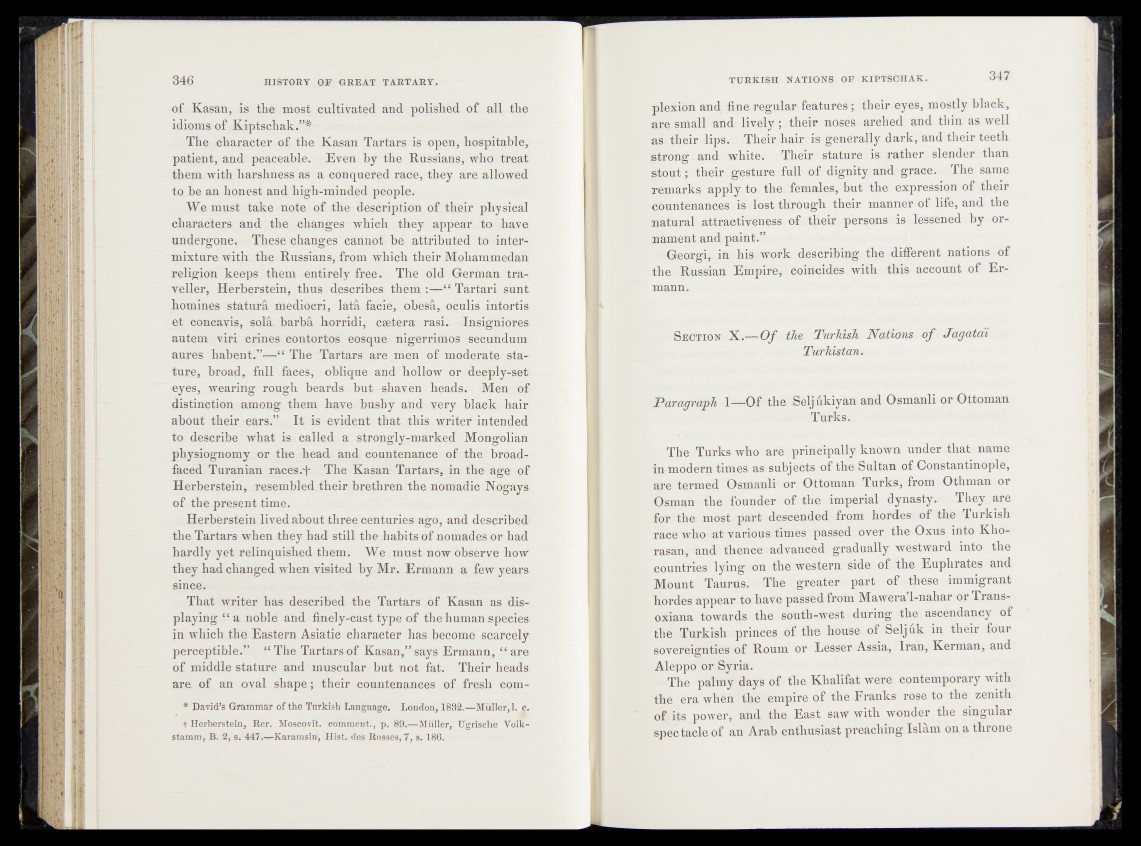
of Kasan, is the most cultivated and polislied of all the
idioms of Kiptschak.”*-
. The character of the Kasan Tartars is open, hospitable,,
patient, and peaceable. Even by the Russians, who treat
them with harshness:as a conquered race, they are allowed
to_.be an honest and high-minded people.
We must take note of the description of their physical
characters and the changes which they appear to have,
underg^sm* These changes'cahnot be attributed to inter-
mixture with the Russians, from which their Mohammedan
religion ^keeps them entirely free. The old. German traveller,
Herberstein-, thus describes them :—“ Tartari. sunt
homines statiu^L. mediocri, lata fade,’ obes-ä, ^iulis idtorfe
et concavis, sola barba horridi, caetera rasi» Insi^nibrest
autem viri crines contortos eosque .nigerrimos .secundum
aures h a b e n The Tartars are menhof ip^derate stature,
broad, full faces, oblique and 'hollow or deefdyäsefc
eyes, wearing rough beards :hnt-r-shaveh .heads.--Men bqf
distinction among them- have bushy and svery black hair
about their ears.” It is evident that this writer intended
to describe what is called a strongly-marked Mongolian
physiognomy or the head and countenance of the broadfaced
Turanian races .-p The Kasan- Tartars/dn tbovag^yof
Herberstein, resembled.their brethren the nomadic Nogays.
of the present time.
. Herberstein lived about three centuries'ago, and described
the Tartars when they had still the habits of nomades or had
hardly yet relinquished them. We must now observe how
they had changed when visited by Mr. Ermann a few years
since*
That writer has described the Tartars of Kasan as displaying
“ a noble and finely-cast type of the human species
in which the Eastern Asiatic character has become scarcely
perceptible.” “ The Tartars of Kasan,” says Ermann, “ are
of middle stature and muscular but not fat. Their heads
are of an oval shape ; their countenances of fresh com-
* David’s Grammar of the Turkish Language. London, 1882.—Müller, l .c.
t Herherstein, Rer. Moscdvit. comment., p. 89.—Muller,^Ugrische Volk-
stamm, B. 2, s. 447.—Karamslii, Hist, ties Russes, 7, s. 180.
plexioh and fine regular features; their eyes, mostly black,
are st&all andflively ; their, noses arched and thin as well
as f thibir lips. Their hair is generally dark, and their teeth
strong and white; Their stature is rather slender than
stout; their ^estmle; full of dignity and grace. The same
remarks apply, teethe* females, bnt the expression of their
-countenances is;,lost,through their manneriof life, and the
natural attractiveness of their persons is lessened by ornament
and.paihh^#
Georgi, invhis work describing the different nations of
the Russian Empire, coincides with this account of Er-
mann.
Section X.—Ofth&3?urhish Nations of Jagatdi
TurJiistan.
Paragraph 1—Of the Seljukiyan and Osmanli or Ottoman
Turks.
The Turks who are principally known under that name
in modern times as subjects of tketSultah of Constantinople,
are termed Osmanli or Ottoman Turks, from Othman or
Osman the founder. of the imperial dynasty. They are
for the most part descended from hordes of the Turkish
race who at various times 'passed" over the Oxus into Kho-
rasan, and thence advanced gradually westward into the
countries lying on the western -side of the Euphrates and
Mount Taurus. The greater part o ft these immigrant
hordes appear to have passed from MaweraT-nahar or Trans-
oxiana towards the south-west during the ascendancy of
the Turkish princes of the house of Seljuk in their four
sovereignties of Roum or Lesser Assia, Iran, Kerman, and
Aleppo or Syria.
• The palmy days of the Khalifat were contemporary with
the era when the empire of the Franks rose to the zenith
of-;its power, and the East saw with wonder the singular
spectacle of an Arab enthusiast preaching Islam on a throne